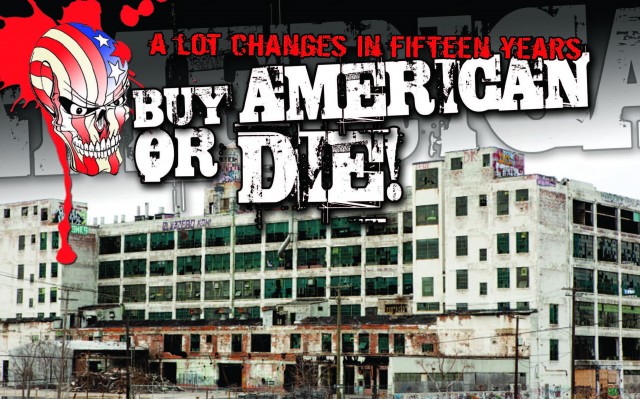A Lot Changes In 15 Years
Article By: Paul Wideman And Nichole Grodski – www.bareknucklechoppers.com
Originally Published In The April 2012 Issue Of Cycle Source Magazine

Cycle Source has always prided itself on being the working man’s cycle mag. For 15 years, The Source has been based in Pittsburgh, PA, once the steel capital of the world. You’ll be hard pressed to find a more blue collar, real world community in this fair country. As the work ethic and hard-nosed principles filtered into the magazine, Cycle Source has always found its way into the hands of bikers and riders of the same ilk; the guys and gals that work for their money. But over these last 15 years, how has the blue collar worker been affected by our government’s policies and lack of attention relative to our manufacturing base? It’s true that as a society develops and the “quality of life” improves, occupational focus will shift from production to services. This basically means we find ourselves in jobs in areas such as trading, banking, science, healthcare, education, and mass media. Developed nations will do this as they have established economies and workforce, and look to other nations for production. In a C sense, we are letting the other guys do the hard work. It’s more difficult to produce and sell to the world if many nations are a half step behind you. Your prices and profits will suffer. But when lesser developed nations do the producing, at reduced wages mind you, and the products are imported for sale to the rest of the world, great profits are realized. Add to that the service sector, and quickly a society adds wealth and prosperity; in theory at least. Perhaps the US is the first modern society to delve so deeply into this stage of development. Many sociologists and economists are rethinking the theories of postindustrial society. At almost the same time the US began to realize the benefits of becoming a service oriented society, the workforce saw huge cuts, layoffs, and unemployment. As our jobs and manufacturing were outsourced, many formerly producing workers were left without employment. This, coupled with some very questionable banking decisions, thrust us all into a global recession. The theory that a society can survive on a primarily service oriented workforce has been tested at the least, and arguably dismissed. While there are literally hundreds, if not thousands, of other factors that have gotten our economy into the mess it’s in, outsourcing is certainly one of the biggest, and one that hits the working man the hardest.
For 15 years the US lost manufacturing jobs. 15 straight years! In 1997, we added 304,000 jobs to our plants and factories. In 2011, we saw our first increase, as we put 136,000 workers back in their boots. This is great news, albeit a humble improvement. We have a lot of ground to make up, as we lost about 2.9 million jobs during the 2001-2003 recession and another 2.5 between 2007 and 2009. The good news is we are expected to add another 330,000 jobs this year, according to economists. Remember Ford Motor Company? They are the US auto manufacturer that did not accept a government bailout. Ford is adding 7,000 jobs over the next two years alone. According to US jobs’ data, our manufacturing jobs average about $22/hour. That is roughly twice the average of the service sector. So yes, you have to work a little harder, but the reward is well worth it. In 1997, the US employed 16,888,000 workers in the manufacturing sector. In December 2011, there were 11,816,000 employed in manufacturing jobs. While there are many positive indicators leading numerous economists to believe our manufacturing base will show us the way to recovery, it is a tricky path. As manufacturing here on our home turf becomes more competitive, automation and more efficient means of production reduce costs and sometimes jobs. During the third quarter of 2011, US manufacturing output grew by 7.1% from the same time period one year earlier, but hours worked grew only 3%. Most American companies are proceeding with extreme caution, opting to increase automation and utilizing temp agencies to avoid future layoffs, severance, and buyout costs. As we have opined numerous times in the past, keeping the government out of US business is a great way to boost production. Tax incentives to American companies and fair tariffs will also increase exports and level out the amount of imports. And before you say that both of those measures are indeed government involvement, be sure that reducing the tax burden on business and assuring goods imported are held to the same standards as our exports, is not government interference. Many US companies are already taking advantage of new tax breaks and energy savings. Maybe our incredibly high gas prices will work in our favor. Shipping products from overseas or trucking them in from Mexico or Canada is increasingly more costly than shipping from plants located throughout the US. Makers of large items such as appliances and heavy equipment have weighed the cost of shipping against higher wages and decided to bring jobs back to the US. Caterpillar is building a large plant in Texas right now to service the US instead of shipping from Japan.
Most importantly, the power of change is in our hands. Of course we can make changes at the ballot box this year, but even bigger changes can be made everyday, as we all Buy American. So many of us rely on manufacturing for our income and we never realize it. It is said that each manufacturing job creates eight more support jobs: truck drivers, accountants, secretaries, administration, any number of jobs are needed when Americans are producing. Maybe not you, but your wife, your brother, your best friend, someone you know will be affected if you chose not to Buy American. Ultimately it will affect us all. Let’s leave those big all-night discount store parking lots empty. Let them know that until they support Americans, we will not support them. Vote with the American economy in mind. Buy a few less items, but buy higher quality US made items. Let’s take the next 15 years and get back to where we were. Let’s balance production and service. There’s room for us to do both, as well as so many other countries. If we don’t, we will die as a society.























